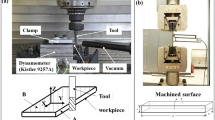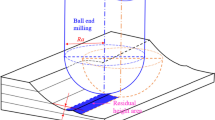Abstract
During the surface milling process, the curved surface components, which were made of carbon fiber-reinforced plastics (CFRP), were prone to complex deformations. These resulted in ineffective material removal, thereby inducing undesirable damages. To address this problem, the present study analyzed the material removal process during the curved surface milling of CFRP components. A novel residual height calculation method, considering the deformation of the curved CFRP surface components, was initially proposed, to describe the material removal quality quantificationally. After applying this method for CFRP cylindrical components, surface milling experiments were conducted, and the influences of the process parameters on material removal were analyzed. Results suggested that reducing the axial cutting depth and the tool feed resulted in better surface appearance and less machining damage of the curved CFRP surfaces, while increasing the spindle speed reduced the machining damage only, but had little effect on the surface appearance. The findings of the present study facilitated the understanding of the material removal law in the surface milling processes of curved CFRP surface components, and also provided foundations for improving milling quality.














Similar content being viewed by others
Data Availability
The raw/processed data required to reproduce these findings cannot be shared at this time as the data also forms part of an ongoing study.
References
Kenichi S, Tetusya N, Toru K (2020) Improvement of safety requirement for launch vehicle payload safety about depressurization and offloading propellant in case of propellant leakage after assembling payload to the vehicle. Journal of Space Safety Engineering 7:101–104. https://doi.org/10.1016/j.jsse.2020.03.002
Li J, Ning T, Xi P, Wang T (2016) Rapid structure design and automated adjustment of missile body. Procedia CIRP 56:84–89. https://doi.org/10.1016/j.procir.2016.10.021
Wang H, Cong W, Ning F, Hu Y (2018) A study on the effects of machining variables in surface grinding of CFRP composites using rotary ultrasonic machining. Int J Adv Manuf Technol 95(9-12):3651–3663. https://doi.org/10.1007/s00170-017-1468-6
Silva D, Teixeira JP, Machado CM (2014) Methodology analysis for evaluation of drilling-induced damage in composites. Int J Adv Manuf Technol 71(9-12):1919–1928. https://doi.org/10.1007/s00170-014-5616-y
Jens W, Axel H, Gerhard Z, Georg L, Nicole S, Marc F Combination of carbon fibre sheet moulding compound and prepreg compression moulding in aerospace industry. Procedia Engineering 81:1601–1607. https://doi.org/10.1016/j.proeng.2014.10.197
Nor F, Abd H, Helen A, Stuart B (2017) Analysis of tool wear, cutting force, and machining temperature during finishing operation of ultrasonic assisted milling (UAM) of carbon fibre reinforced plastic (CFRP). Procedia Engineering 184:185–191. https://doi.org/10.1016/j.proeng.2017.04.084
Chen Y, Guo X, Zhang K, Guo D, Zhou C, Gai L (2018) Study on the surface quality of CFRP machined by micro-textured milling tools. J Manuf Process 37:114–123. https://doi.org/10.1016/j.jmapro.2018.11.021
Sheikh-Ahmad J, El-Hofy M, Almaskari F, Kerrigan K, Takikawa Y (2019) The evolution of cutting forces during slot milling of unidirectional carbon fiber reinforced polymer (UD-CFRP) composites. Procedia CIRP 85:127–132. https://doi.org/10.1016/j.procir.2019.09.043
EI-Hofy M, Soo S, Aspinwall D, Sim W, Pearson D, M’Saoubi R, Harden P (2017) Tool temperature in slotting of CFRP composites. Pro Manuf 10:371–381. https://doi.org/10.1016/j.promfg.2017.07.007
Wang F, Zhang B, Zhao M, Cheng D, Wang Z (2019) Evolution laws of fiber-matrix interface cracks in machining of carbon fiber reinforced polymer. Int J Adv Manuf Technol 101:963–977. https://doi.org/10.1007/s00170-018-2992-8
Jia Z, Su Y, Niu B, Zhang B, Wang F (2016) The interaction between the cutting force and induced sub-surface damage in machining of carbon fiber-reinforced plastics. J Reinforc Plas Compos 35:712–726. https://doi.org/10.1177/0731684415626284
Han X, Hou S, Ying L, Hou W, Aliyev H (2019) On the fracture behaviour of adhesively bonded CFRP hat-shaped thin-walled beam under axial crushing load: an experimental and modelling study. Compos Struct 215:258–265. https://doi.org/10.1016/j.compstruct.2019.01.075
Dervis O, Mustafa S, Mecit O, Abdullah C (2019) Milling behavior analysis of carbon fiber-reinforced polymer (CFRP) composites. Mater Today Proc 11:526–533. https://doi.org/10.1016/j.matpr.2019.01.024
Wang C, Liu G, An Q, Chen M (2017) Occurrence and formation mechanism of surface cavity defects during orthogonal milling of CFRP laminates. Compos Part B Eng 109:10–22. https://doi.org/10.1016/j.compositesb.2016.10.015
Wang F, Zhang B, Jia Z, Zhao X, Wang Q (2019) Structural optimization method of multitooth cutter for surface damages suppression in edge trimming of carbon fiber reinforced plastics. J Manuf Process 46:204–213. https://doi.org/10.1016/j.jmapro.2019.09.013
Wang F, Zhang B, Ma J, Bi G, Hu H (2019) Computation of the distribution of the fiber-matrix interface cracks in the edge trimming of CFRP. Appl Compos Mater 26:159–186. https://doi.org/10.1007/s10443-018-9687-z
Haddad M, Zitoune R, Bougherara H (2014) Study of trimming damages of CFRP structures in function of the machining processes and their impact on the mechanical behavior. Compos Part B 57:136–143. https://doi.org/10.1016/j.compositesb.2013.09.051
El-Hofy M, Soo S, Aspinwalla D, Sim W, Pearson D, Harden P (2011) Factors affecting workpiece surface integrity in slotting of CFRP. Procedia Eng 19:94–99. https://doi.org/10.1016/j.proeng.2011.11.085
Li M, Huang M, Jiang X, Kuo C, Yang X (2018) Study on burr occurrence and surface integrity during slot milling of multidirectional and plain woven CFRPs. Int J Adv Manuf Technol 97:163–173. https://doi.org/10.1007/s00170-018-1937-6
Steffen T, Wu T, Thomas T, Thomas N (2020) A micromechanical-based finite element simulation of process-induced residual stresses in metal-CFRP-hybrid structures. Compos Struct 238:111926. https://doi.org/10.1016/j.compstruct.2020.111926
Segonds S, Seitier P, Bordreuil C (2019) An analytical model taking feed rate effect into consideration for scallop height calculation in milling with torus-end cutter. J Intell Manuf 30:1881–1893. https://doi.org/10.1007/s10845-017-1360-0
Wang C, Wen L, Wang C, Zhang H, An Q, Chen M (2015) Influence of fiber orientation on machined surface quality in milling of unidirectional CFRP laminates. Adv Mater Res 1136:137–142. https://doi.org/10.4028/www.scientific.net/AMR.1136.137
Xin W, Parick YK, Caleb S, Dave (Dae-Wook) K, Jeff L (2013) Tool wear of coated drills in drilling CFRP. J Manuf Process 15:127–135. https://doi.org/10.1016/j.jmapro.2012.09.019
Gururaja S, Ramulu M (2009) Failure analysis of a fibrous composite half-space subjected to uniform surface line load. J En Mater-T ASME 131:1–8. https://doi.org/10.1115/1.3086386
Funding
This work was supported by the National Key R&D Program of China (Grant No. 2018YFA0702803); The Major Program of the National Natural Science Foundation of China (grant number 52090053); National Natural Science Foundation for Young Scholars of China (grant number 52005077); Liaoning Revitalization Talents Program (Grant Nos. XLYC1902014, XLYC1801008, and XLYCYSZX1901); and Fundamental Research Funds for the Central Universities.
Author information
Authors and Affiliations
Contributions
Fuji Wang and Yue Li conceived and designed the study. Yue Li and Junfeng Fan performed the experiments. Yue Li and Boyu Zhang wrote the paper. Boyu Zhang, Lelin Yang, and Yongquan Lin reviewed and edited the manuscript. All authors read and approved the manuscript.
Corresponding author
Ethics declarations
Ethics approval and consent to participate
Not applicable.
Consent for publication
The author confirms that the work has not been published before; that it is not under consideration for publication elsewhere; that its publication has been approved by all co-authors; that its publication has been approved by the responsible authorities at the institution where the work is carried out.
Competing interests
The authors declare no competing interests.
Additional information
Publisher’s note
Springer Nature remains neutral with regard to jurisdictional claims in published maps and institutional affiliations.
Rights and permissions
About this article
Cite this article
Wang, F., Li, Y., Zhang, B. et al. Influence of process parameters on material removal during surface milling of curved carbon fiber-reinforced plastic (CFRP) components: evaluated by a novel residual height calculation method. Int J Adv Manuf Technol 116, 3405–3415 (2021). https://doi.org/10.1007/s00170-021-07590-6
Received:
Accepted:
Published:
Issue Date:
DOI: https://doi.org/10.1007/s00170-021-07590-6




